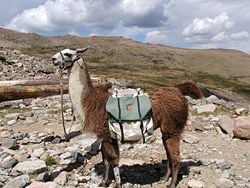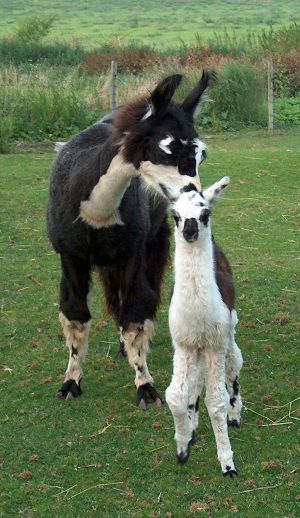Llama
| Llama | ||||||||||||||
|---|---|---|---|---|---|---|---|---|---|---|---|---|---|---|
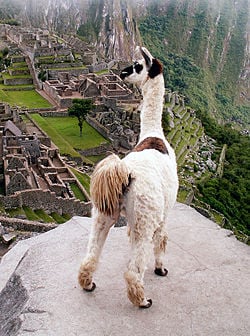 A llama overlooking Machu Picchu, Peru
| ||||||||||||||
|
Domesticated
| ||||||||||||||
| Scientific classification | ||||||||||||||
| ||||||||||||||
| Lama glama (Linnaeus, 1758) |
The llama is a domesticated, gregarious, South American ungulate, Lama glama, of the camel family (Camelidae), characterized by long neck and legs, protruding lower incisors, inwardly curved tips of the ears, a cleft and prehensile upper lip, and two toes on each foot. While its native range is along the Andes mountains, this large herbivorous mammal is no longer found in the wild, but is maintained extensively in herds in Argentina, Bolivia, Chile, Ecuador, and Peru; it is commercially raised as well on other continents (North America, Europe, and Australia).
The llama has long been used as a pack animal, including by the Incas, for whom they were the empire's primary transportation source (NG 2008). They also have been used, traditionally and today, for their wool (textiles), dung (fuel and fertilizer), hide (leather), and meat (food).
Overview and description
Llamas are even-toed ungulates (order Artiodactyla), with two-toes on each foot and an "unguligrade" form of locomotion. (Unguligrade involves most of the weight of the animal supported by the hoofs, in contrast with "digitigrade," where the toes touch the ground, or "plantigrade," where the entire foot is on the ground, as in humans.) There are three other camelids in South America, the domesticated alpaca (Lama pacos), and the wild guanaco (Lama guanicoe) and vicuña (Vicugna vicugna). The alpaca is sometimes placed in the Vicugna genus (Vicugna pacos).
The llama has long legs and a long neck. The face is camel-like, with an upper lip that is cleft and prehensile. The ears are rather long and slightly curved inward, characteristically known as "banana" shaped. The tail is short. There is no dorsal hump as in the camels. The feet are narrow, the toes being more separated than in the camels, each having a distinct plantar pad.
The body color can vary greatly. It commonly is a reddish brown color that is uniform over the body, but it may be more of a solid white or black, and may also be piebald (pattern of large white and black patches). The legs, face, and ears may be black, white, or mixed. The fiber is long and woolly; overall, the fiber produced by a llama is very soft and is naturally lanolin free.
The height of a full-grown, full-size llama is between 5.5 feet (1.6 meters) to 6 feet (1.8 m) tall at the top of the head. They can weigh between approximately 280 pounds (127 kilograms) and 450 pounds (204 kilograms). At birth, a baby llama (called a cria) can weigh between 20 pounds (9 kilograms) to 30 pounds (14 kilograms).
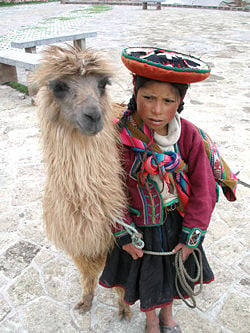
Llamas retain only one upper incisor as adults and there is a considerable distance between the premolars and the incisors (Portman and Myers 2004). Dentition of adult llamas is incisors 1/3, canines 1/1, premolars 2/2, molars 3/2 (or3/3); total 32. In the upper jaw there is a compressed, sharp, pointed laniariform incisor near the hinder edge of the premaxilla, followed in the male at least by a moderate-sized, pointed, curved spank canine in the anterior part of the maxilla. The isolated canine-like premolar that follows in the camels is not present. The teeth of the molar series, which are in contact with each other, consist of two very small premolars (the first almost rudimentary) and three broad molars, constructed generally like those of Camelus. In the lower jaw, the three incisors are long, spatulate, and procumbent; the outer ones are the smallest. Next to these is a curved, suberect canine, followed after an interval by an isolated minute and often deciduous simple conical premolar; then a contiguous series of one premolar and three molars, which differ from those of Camelus in having a small accessory column at the anterior outer edge.
The skull generally resembles that of Camelus, the relatively larger brain-cavity and orbits and less developed cranial ridges being due to its smaller size. The nasal bones are shorter and broader, and are joined by the premaxilla. There are 7 cervical vertebrae, 12 dorsal vertebrae, 7 lumbar vertebrae, 4 sacral vertebrate, and from 15 to 20 caudal vertebrae.
The circulatory system of llamas is adapted for surviving in the Andean highlands, with an unusually high content of hemoglobin and oval shaped red blood corpuscles (Portman and Myers 2004).
The llama and alpaca are only known in the domestic state. The guanaco and vicuña are wild. The llamas are the largest members of this group. The llama also has a longer head than the alpaca, and the vicuña, relative to the guanaco, is smaller, more slender in its proportions, and with a shorter head. The most apparent visual difference between llamas and camels is that camels have a hump or humps and llamas do not. Llamas do not have eyelashes. However, their cousin, the alpaca, does.
All of these camelids digest their food by the process of rumination. Their stomachs are divided into three chambers (Nowak 1983). After food is swallowed, it is kept in the first chamber for a while where it is partly digested with the help of bacteria and protists.
Behavior and diet
Llamas are herbivorous, browsing on shrubs, lichens, grasses, and other mountain vegetation. They get most of their water from their food (Portman and Myers 2004).
Llamas are gregarious and very social animals, living in groups (a herd). Groups of up to about twenty individuals (six breeding females and their offspring form current year) are led by a male llama, which uses dominance fighting to defend his position (Portman and Myers 2004). Llamas sometimes spit at each other as a way of disciplining lower-ranked llamas in the herd. A llama's social rank in a herd is never static. They can always move up or down in the social ladder by picking small fights. This is usually done between males to see who becomes alpha. Their fights are visually dramatic with spitting, ramming each other with their chests, neck wrestling and kicking, mainly to knock the other off balance. The females are usually only seen spitting as a means of controlling other herd members. While the social structure might always be changing, llamas live as a family and they do take care of each other. Llamas also are known to use communally shared locations for feces (latrines).
Like other camelids, llamas are vocal, using a variety of low and yammering calls (Portman and Myers 2004). If one llama notices a strange noise or feels threatened, a warning bray is sent out and all others come to alert. They will often hum to each other as a form of communication.
The sound of the llama making groaning noises or going "mwa" is often a sign of fear or anger. If a llama is agitated, it will lay its ears back. One may determine how agitated the llama is by the materials in the spit. The more irritated the llama is, the further back into each of the three stomach compartments it will try to draw materials from for its spit.
Llamas are considered to be intelligent and can learn simple tasks after a few repetitions.
Llamas that are well-socialized and trained to halter and lead after weaning are very friendly and pleasant to be around. They are extremely curious and most will approach people easily. However, llamas who are bottle-fed or over-socialized and over-handled as youngsters will become extremely difficult to handle when mature, when they will begin to treat humans as they treat each other, which is characterized by bouts of spitting, kicking, and neck wrestling. Anyone having to bottle-feed a cria should keep contact to a minimum and stop as soon as possible. When correctly reared, spitting at a human is a rare thing.
Reproduction
Llamas are polygamous. They also have an unusual reproductive cycle for a large animal. Female llamas are induced ovulators. The female llamas undergo induced ovulation after mating, with the ovum released abuot 24 to 36 hours after copulation. They do not go into "heat" or have an estrus cycle. Gestation is long, taking about 350-360 days, with birth given to one infant llama, known as a cria, every year. Newborn crias can run about one hour after birth and are nursed for four months (Portman and Myers 2004).
Like humans, llama males and females mature sexually at different rates. Females reach puberty at approximately 12 months. However, males do not become sexually mature until approximately 3 years (Johnson 1989).
An "orgle" is the mating sound of a llama or alpaca, made by the sexually aroused male. The sound is reminiscent of gargling, but with a more forceful, buzzing edge. Males begin the sound when they become aroused and continue throughout the act of procreation—from 15 minutes to more than an hour (Pinkerton and Pinkerton). Llamas mate with the female in a kush (lying down) position, which is fairly unusual in a large animal. The extended period of time when mating also is unusual in a large animal.
Llamas make quite a variety of sounds. The most common sound is a humming noise. A female will hum to her cria, which seems to reassure the baby that mom is still around.
Origins and history
Llamas appear to have originated from the central plains of North America about 40 million years ago. They migrated to South America and Asia about 3 million years ago. By the end of the last ice age (10,000–12,000 years ago) camelids were extinct in North America (DAS 1998).
Abundant llama-like remains have been found in Pleistocene deposits in the Rocky Mountains of North America and in Central America. Some of the fossil llamas were much larger than current llamas. Some species remained North America during the last ice ages. About 25,000 years ago, llama-like animals would have been a common sight in modern-day California, Texas, New Mexico, Utah, Missouri, and Florida.
There are few groups of mammals for which the paleontological history has been so satisfactorily demonstrated as the llama. Many camel-like animals have been traced from the modern epoch down through the Pliocene to the early Miocene beds. Their characteristics became more general, and they lost those that especially distinguished them as Camelidae; hence they were classified as forms of the common ancestral Artiodactyl taxon.
The llama was widely used as a beast of burden by the Incas and other natives of the Andes mountains of South America. Although the Incas had a vast mountain road system, they lacked wheels, and llamas were used to carry all types of loads, including building materials and water. They provided dung for fuel and fertilizer, wool for clothing, and after their deaths, were used for food and the hide for leather (NG 2008). However, llamas cannot bear heavy burdens, cannot transport human beings, and cannot pull a plow (Diamond 2005a).
The Inca deity Urcuchillay was depicted in the form of a multicolored llama (D'Altroy 2002). The Moche people frequently placed llamas and llama parts in the burials of important people, as offerings or provisions for the afterlife (Berrin and Larco 1997). The Moche culture of pre-Columbian Peru depicted llamas quite realistically in their ceramics.
One of the main uses for llamas at the time of the Spanish conquest of the Inca Empire was to bring down ore from the mines in the mountains (Diamond 2005a). One observer in Bolivia estimated that in his day, as many as three hundred thousand llamas were employed in the transport of produce from the Potosí mines alone, but since the introduction of horses, mules, and donkeys, which can pull greater weights and transport people, the importance of the llama as a beast of burden has greatly diminished (Diamond 2005b).
In South America llamas are still used as beasts of burden, as well as for the production of fiber and meat (Larson and Ho 2007). As of 2007, there were over 7 million llamas and alpacas in South America and, due to importation from South America in the late twentieth century, there are now over 100,000 llamas and 6,500–7,000 alpacas in the U.S. and Canada (SCLA 2007).
Although early writers compared llamas to sheep, their similarity to the camel was very soon recognized. They were included in the genus Camelus in the Systema Naturae of Linnaeus. They were, however, separated by Cuvier in 1800 under the name of llama along with the alpaca and the guanaco. Vicuñas are in genus Vicugna. The animals of the genus Lama are, with the two extant species of true camels, the sole existing representatives of a very distinct section of the Artiodactyla or even-toed ungulates, called Tylopoda, or "bump-footed," from the peculiar bumps on the soles of their feet, on which they tread.
Llama fiber
Llamas have a fine undercoat that can be used for handicrafts and garments. The coarser outer guard hair is used for rugs, wall-hangings, and lead ropes. The fiber comes in many different colors ranging from white, gray, reddish brown, brown, dark brown, and black.
These fibers are commonly referred to as llama wool or llama fiber, although they differ from the fiber of animals of the Caprinae family, such as sheep, for whom the term wool is sometimes reserved. Llama fiber is hollow with a structure of diagonal "walls," which makes it strong, light, and good insulation.
The individual shafts of the wool can be measured in micrometers (1 micrometer = 1/1000 millimeter.)
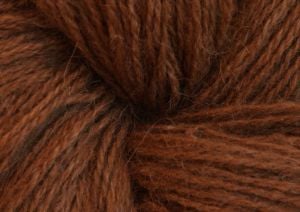
| Animal | Fiber diameter (micrometres) |
|---|---|
| Vicuña | 6 – 10 |
| Alpaca (Suri) | 10 - 15 |
| Muskox (Qivlut) | 11 - 13 |
| Merino | 12 - 20 |
| Angora Rabbit | 13 |
| Cashmere | 15 - 19 |
| Yak Down | 15 - 19 |
| Camel Down | 16 - 25 |
| Guanaco | 16 - 18 |
| Llama (Tapada) | 20 - 30 |
| Chinchilla | 21 |
| Mohair | 25 - 45 |
| Alpaca (Huacaya) | 27.7 |
| Llama (Ccara) | 30 - 40 |
ReferencesISBN links support NWE through referral fees
This article originally incorporated text from the Encyclopædia Britannica Eleventh Edition, a publication now in the public domain.
- Berrin, K., and Larco Museum. 1997. The Spirit of Ancient Peru: Treasures from the Museo Arqueológico Rafael Larco Herrera. New York: Thames and Hudson. ISBN 0500018022.
- D'Altroy, T. N. 2002. The Incas. Malden, Mass.: Blackwell. ISBN 9780631176770.
- Department of Animal Science (DAS). 1998. Llama. Oklahoma State University. Retrieved October 4, 2008.
- Diamond, J. 2005a. Guns, germs & steel. The show: Episode two. PBS. Retrieved October 3, 2008.
- Diamond, J. 2005b. Guns, germs & steel. The story of Llamas. PBS. Retrieved October 3, 2008.
- Huffman, B. 2007. What is an ungulate? Ultimate Ungulate. Retrieved October 4, 2008.
- Integrated Taxonomic Information System (ITIS). 2004. Lama G. Cuvier, 1800. ITIS Taxonomic Serial No.: 624943. Retrieved October 2, 2008.
- Johnson, L. W. 1989. Llama reproduction. Vet Clin North Am Food Anim Pract. 5(1):159-82. Retrieved October 4, 2008.
- Larson, J., and J. Ho. 2007. Information resources on the South American camelids: Llamas, alpacas, guanacos, and vicunas 1943-2006. USDA. Retrieved October 3, 2008.
- National Geographic (NG). 2008. Little llamas. National Geographic. Retrieved October 4, 2008.
- Nowak, R. M., and J. L. Paradiso. 1983. Walker's Mammals of the World. Baltimore: Johns Hopkins University Press. ISBN 0801825253.
- Pinkerton, B, and J. Pinkerton. n.d. What kind of sounds do they make? Humm Page. Retrieved October 4, 2008.
- Portman, C., and P. Myers. 2004. Lama glama. Animal Diversity Web. Retrieved October 02, 2008.
- South Central Llama Association (SCLA). 2007. Llama facts. South Central Llama Association. Retrieved October 3, 2008.
- Williams, B. 2007. Llama fiber. International Llama Association. Retrieved October 3, 2008.
Credits
New World Encyclopedia writers and editors rewrote and completed the Wikipedia article in accordance with New World Encyclopedia standards. This article abides by terms of the Creative Commons CC-by-sa 3.0 License (CC-by-sa), which may be used and disseminated with proper attribution. Credit is due under the terms of this license that can reference both the New World Encyclopedia contributors and the selfless volunteer contributors of the Wikimedia Foundation. To cite this article click here for a list of acceptable citing formats.The history of earlier contributions by wikipedians is accessible to researchers here:
The history of this article since it was imported to New World Encyclopedia:
Note: Some restrictions may apply to use of individual images which are separately licensed.
